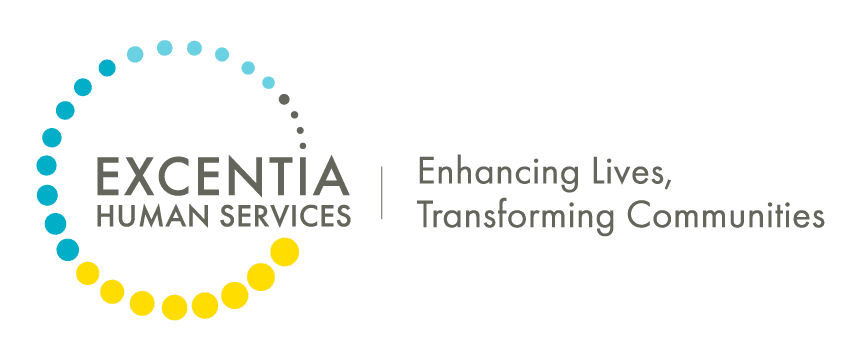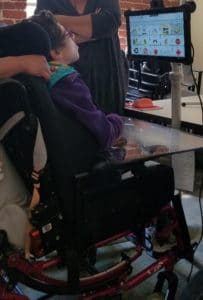When I first met Vanessa at her home, her vibrant personality greeted me at the door. For those who do not know her, Vanessa is very expressive and curious about everything that is happening in her environment. She will maneuver her body to see what is occurring in any direction and utilizes all of her capabilities to respond to others. She communicates through a combination of vocalizations, neck, body and eye movements. To the untrained eye it appears she can share her likes and dislikes, answer yes and no questions and show joy and sadness. As someone from the speaking world, I recognized the limited range of expressive language and emotions that she had in her repertoire. It was obvious from our initial meetings that what she lacked in expressive communication, she compensated with her effervescent personality, which captivated those around her. Unfortunately, this illusion of communication may have veiled the need for further examination to enhance her basic methods.
Mobility for Vanessa means confinement to a wheelchair, apart from laying in a recliner or bed. She can move her head and hands, and with intense effort, parts of her lower body and torso. She depends on others to complete all daily needs and to understand her language. Her limited ability to communicate with the world outside of her chair causes Vanessa extreme frustration which can manifest into aggressive and harmful behaviors. Her means of communication at the time consisted of a slight nod or swift side movement of her head (for “yes” and “no”), facial expressions, laughing, vocalizations, body language, and formulation of some single words that at that time were translated by staff to the best of their ability. She has a whiteboard in her bedroom that informs her of what staff are working, any upcoming events or changes to her routine to reduce her anxiety. Vanessa loves books and uses her eyes to identify choices when presented with pictures, but this is a time-consuming process with limited options.
One day, her housemate purchased a picture communication book which sparked Vanessa’s interest immediately. She requested to look at it constantly. It was decided that it made sense to have a much larger picture book so she could use her fingers to point and work on her fine motor skills simultaneously. This was not an area that I had previously explored, but I felt there must be someone who could assist her with increasing her abilities beyond this book. After some research, I found an agency that would complete a communication assessment for Vanessa. This was a novel concept to me, and I had no idea what to expect. A specialist visited with her team and assessed Vanessa through interviews, historical information, and physically with assistive technology. After it was over, Vanessa had the opportunity to use an iPad and switch instead of her book. She worked with her staff to create pictures of places she liked to visit, activities in which she wanted to participate, clothes she wanted to wear. This opened a window for her to speak, and however basic those words were, they were hers.
This opened a window for me as well. My mind started to see the connections communication had with everything. When walking through our day program, I saw a reoccurring vacancy between almost every individual and staff. I was thinking, “How did I miss this?! Why didn’t any of us question the lack of communication coming from all of these places?” My focus turned to those speaking – the staff. I heard staff offering options, then making the decisions, then changing the activity, and repeating the same format over again. What did I hear from the individuals? I heard silence. To give a realistic description, a room can be a loud, chaotic place at times, full of noises, music, TV, people. But the silence I heard was evident, and it was the deprivation of meaningful conversation. My next question was, “Now that I see it, what am I going to do about it?” I began reading and investigating communication and devices, seeking out as much knowledge as quickly as possible. I had to be less of a novice I was if I was going to convince others how much these systems and assessments were needed.
My former supervisor didn’t need much convincing and was supportive from the start. She introduced me to an amazing person, Heather Smith, a Speech-Language Pathologist from our Early Childhood program. Heather ended up being the most valuable part of this project. She took my scattered thoughts and made them into a singular vision – to one day walk through the program rooms and hear the individuals speak to staff, to themselves, and to each other. Highly motivated with this revelation, Heather and I blindly embarked on a journey to create a utopia of voices and ran. We compensated for what we didn’t know with good intentions and the desire to do whatever was needed and to do it well. I couldn’t have designed a better partner, as she had years of experience working in early intervention with communication services that are a fundamental part of a child’s plan, but not a readily available service for adults. I found that some adults owned devices, but they were outdated and had been sitting unused for years. Heather and I fumbled through identifying what services we could provide and how to offer them to everyone.
Fast forwarding a few months, Heather has completed multiple assessments with adults in our day program and residential homes. There are communication boards and books in all day program rooms. Individuals have access to iPads with communication applications to begin their own journey. In between her two primary jobs, Heather has acquired a permanent device for one individual and others have trial devices, including Vanessa, to peruse which is the most functional for each of their needs. Recently, we had the second session with a representative for a device that can use a person’s eye gaze or head tracking to access the images on screen instead of a switch or fingers. Now Vanessa no longer struggles to maintain control over her hands to push a button, but can speak fluently with the motion of her head. When I greeted her last time, she said, “Hi, my name is Vanessa.” It was so shocking to me, even knowing she was capable, that I continued to ask her questions and only realized after walking away from her, that we just had our first reciprocal conversation.
Before this world of Augmentative and Assistive Communication revealed itself to me, I could summarize the best part of my job as helping others experience high quality lives. Now the best part of my job is to witness them discover what it means to truly actualize it.



